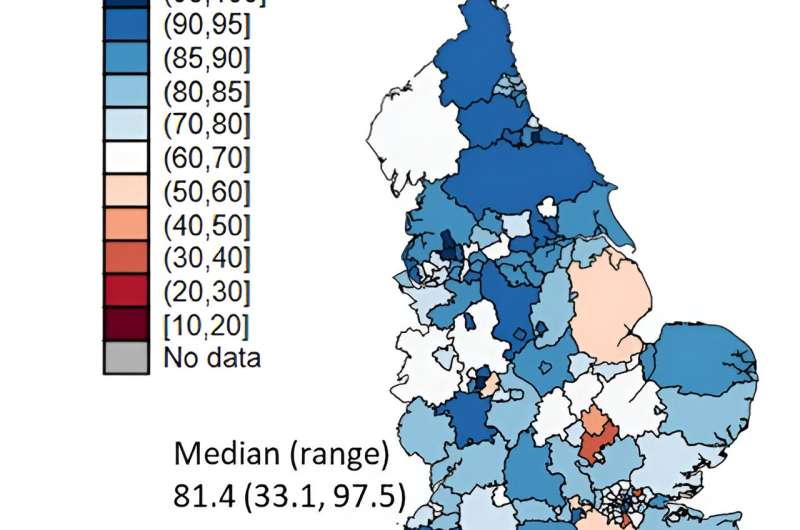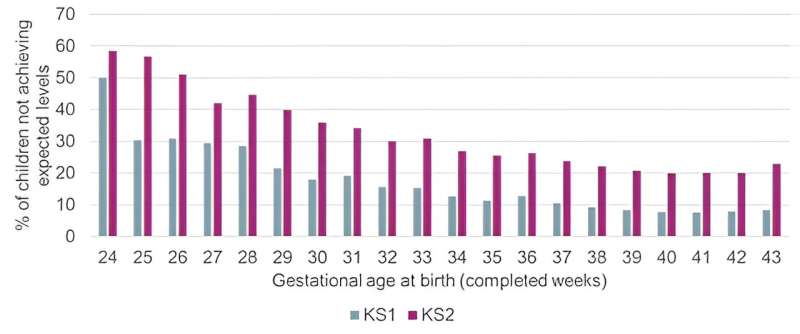This article has been reviewed according to Science X's editorial process and policies. Editors have highlighted the following attributes while ensuring the content's credibility:
fact-checked
peer-reviewed publication
trusted source
written by researcher(s)
proofread
Child health is in crisis in the UK—here's what needs to change

A new report from the Academy of Medical Sciences highlights the "appalling decline" in child health and a need for "urgent action". In recent years, child vaccination rates have fallen well below World Health Organization target levels, creating a resurgence of outbreaks of serious disease such as measles.
In England, more than one in five children are overweight or obese by age five and one in four children have tooth decay. Demand for child mental health services has surged. Perhaps most worryingly, the rise in infant mortality means that UK is now ranked 30 out of 49 OECD countries—well behind other European countries except Bulgaria, Romania and Slovakia.
One of the most important drivers of this crisis is the number of children in the UK living in extreme poverty, which tripled between 2019-2022.
The early years, the period from pregnancy to the first five years of life, have historically been overlooked in research and policy. More recently, the first 1,001 days from conception to age two has been recognized as a critical period in which the building blocks for lifelong emotional and physical health are laid down.
Investing in the early years is one of the most important things we can do as a society to build a better future and promote the nation's health, well-being and prosperity. There is clear evidence that such investment will be cost-effective in enabling future adults to live long and productive lives.
For example, data from the Royal Foundation and the London School of Economics has shown that the cost to society of addressing issues that might have been avoided through action in early childhood is more than £16 billion each year—nearly five times the total annual spend in England on early education and childcare entitlements.
How to reverse the decline
So what can be done to reverse these worrying trends?
The Academy of Medical Sciences' report outlines several recommendations to improve the health and well-being of children in the UK and the adults they will become.
The first recommendation is to implement effective early years interventions. One example of such an intervention is the Family Nurse Partnership (FNP), an intensive early home visiting program for first time teenage mothers. The FNP aims to improve birth outcomes, child health and development, and promote economic self-sufficiency among young mothers.

My colleagues and I recently evaluated outcomes of 26,000 mothers in England participating in the FNP from 2010-2019. We found some evidence to suggest that children born to mothers enrolled in FNP were more likely to achieve a good level of development at school entry (age five), supporting findings from a previous trial. Mothers were engaged in the program, with the majority meeting fidelity targets (Figure 1).
However, in local areas where the FNP was offered, only one in four mothers are enrolled due to insufficient places on the program. In areas with high numbers of teenage mothers, enrollment rates are even lower. More needs to be done to ensure that when interventions are implemented, they are offered to all those who could benefit from support.
A further recommendation is to address the decline in the child and family health workforce. Health visitors are trained nurses who are uniquely placed to influence and work with the whole family in the interests of children on social, psychological and health choices. Years of austerity, cuts and a depleted workforce have meant that since 2015, the health visiting workforce has decreased by 37% (from 11,193 to 7,030 in 2022).
The real term value of the public health grant from which health visiting is commissioned has fallen by 27%. In the context of this disinvestment, there is huge variation in how local areas are delivering their services. For example, our research has shown that the number of children receiving their (mandated) 2 to 2½-year review ranges between 33%-97% depending on in which area they live (Figure 2).
Investment in targeted interventions and universal services in the early years is key to supporting the health and development of children and the well-being of their families in the critical period before school.

Children need joined-up thinking
However, such interventions and policies should be underpinned by high-quality research and evaluation. We need to consider the wider determinants of health and well-being across the lifecourse, such as education, social care income, criminal justice and the environment, to support a more joined up and cross-government approach to improving outcomes.
Historically, linking cross-sectoral data in this way has been challenging. However, there is promising progress in this area. One example of this is Echild, a national resource linking together data from hospitals, schools and social care for 20 million children in England and their mothers (Figure 3).
This unique data set represents a significant step towards a more holistic approach to understanding the many factors influencing child well-being, including maternal mental health, childhood chronic conditions and school absences.
More information: Francesca Cavallaro et al, Intensive home visiting for adolescent mothers in the Family Nurse Partnership in England 2010–2019: a population-based data linkage cohort study using propensity score matching, BMJ Public Health (2024). DOI: 10.1136/bmjph-2023-000514
This article is republished from The Conversation under a Creative Commons license. Read the original article.![]()



















